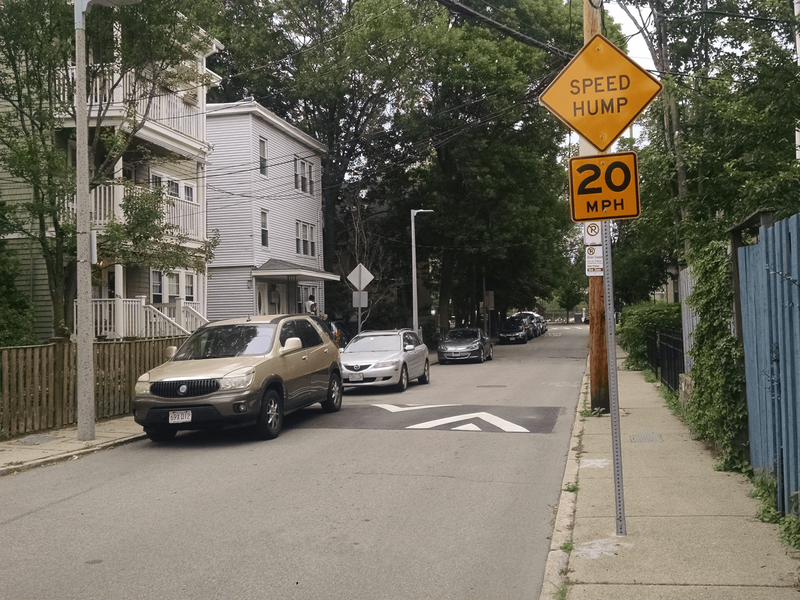Making Neighborhood Streets Safer
A simple tool like a speed hump reduces car speeds and creates a more comfortable environment for those that live, walk, and bike in our neighborhoods.
Speed humps are a primary tool to address traffic speeds and make our neighborhoods more comfortable for people who live, walk, bike, and play there.
Speed humps in the City of Boston
Boston’s speed humps are not like the speed bumps you may encounter in a parking lot.
Speed humps are gradual mounds of asphalt built into the pavement. They are about 3 inches high and between 12 and 14 feet long. Speed humps are comfortable to drive over at 20 miles per hour or less.
We paint white triangles on the street and install yellow “Speed Hump” signs so drivers are aware.
Speed humps are only used on smaller neighborhood streets. They are not appropriate for wider, busier streets or for streets with MBTA bus routes.
We always build speed humps in a series. On any given street, drivers will encounter a speed hump every 150 to 250 feet. Because they can see the next speed hump ahead, people are more likely to drive a consistent, slower speed.
We build speed humps on a group of streets at once. This prevents drivers from simply taking a street one block further away to avoid speed humps.
Speed humps do not impede street sweeping, snow plowing, or street parking.
Speed humps on your street
Over the next three years, we will be working to design and build speed humps in many neighborhoods of Boston. It will take time to get this work done, and our program is being updated to better match the needs of the community. Reaching out to your neighborhood's Office of Neighborhood Services liaison is a great way to make your feedback heard as part of this process.
Search for streets eligible for speed humps
Common Questions
QuestionsContacting your neighborhood's Office of Neighborhood Services liaison is a great way to make your feedback heard as part of this process. While we aim to provide speed humps on all eligible streets where neighbors want them, some streets that are hilly or curvy will not get speed humps. Streets with more than two lanes, major roadways, and streets with MBTA bus routes will also not be eligible for speed humps.
You will receive information by mail when your neighborhood’s streets are being considered for speed humps. You will also hear from the City ahead of construction.
The City of Boston has installed speed humps and other traffic-calming tools on streets in Dorchester, Jamaica Plain, Roxbury, and South Boston. This map shows our progress on where speed humps have been installed.
Drivers traveling will encounter a speed hump approximately every 150 feet to 350 feet. If they travel at appropriate speeds, they will be able to comfortably traverse the speed humps. Because speed humps are more gradual than speed bumps, cars will not “bottom out” or cause excessive noise. Speed humps do not interfere with on-street parking.
Our speed humps are designed to be relatively comfortable to traverse while riding a bike. They use a sinusoidal curve and are built into the subsurface of the street. This makes for a smoother ride up and down than you may find with speed bumps in parking lots.
Speed humps do not prevent plows from clearing our streets. Maps of streets with speed humps are shared with our team in Public Works and their contractors. In the case of a snow event, the yellow “speed hump” signs provide advance notice to the plow drivers to lift their blades slightly.
Streets eligible for speed humps are typically smaller, neighborhood streets and not streets primarily used for emergency response. Emergency vehicles are able to maneuver speed humps placed on neighborhood streets to reach their destination effectively.
In May 2023, the City of Boston adopted a new Speed Hump Policy and Design Directive. This document builds on our earlier policies for traffic-calming and pedestrian safety. It incorporates national best practices as well as what we have learned works best for Boston.
You can also view our typical design detail for speed humps.
Every zone was analyzed using the most recent and accurate data. For crash history, we looked at crashes resulting in response from Boston EMS between January 1, 2018 and December 31, 2022. Our source for demographic data is the U.S. Census Bureau's 5-year American Community Survey, analyzed at the block group level.
To understand safety on these streets in the past five years, we looked at crashes that resulted in a call to Boston EMS. We counted how many crashes happened on the streets in each zone. Then, we divided the total number of crashes by the number of miles of eligible streets in that zone.
We know that some people are more likely to be seriously injured or killed in a car crash: younger people, our elders, and our neighbors with disabilities. We used information from the U.S. Census to approximate how many of these more vulnerable people lived in each group of streets.
We are also working with the Office of Neighborhood Services to conduct outreach to ensure that the speed hump zones match the needs of the community.


